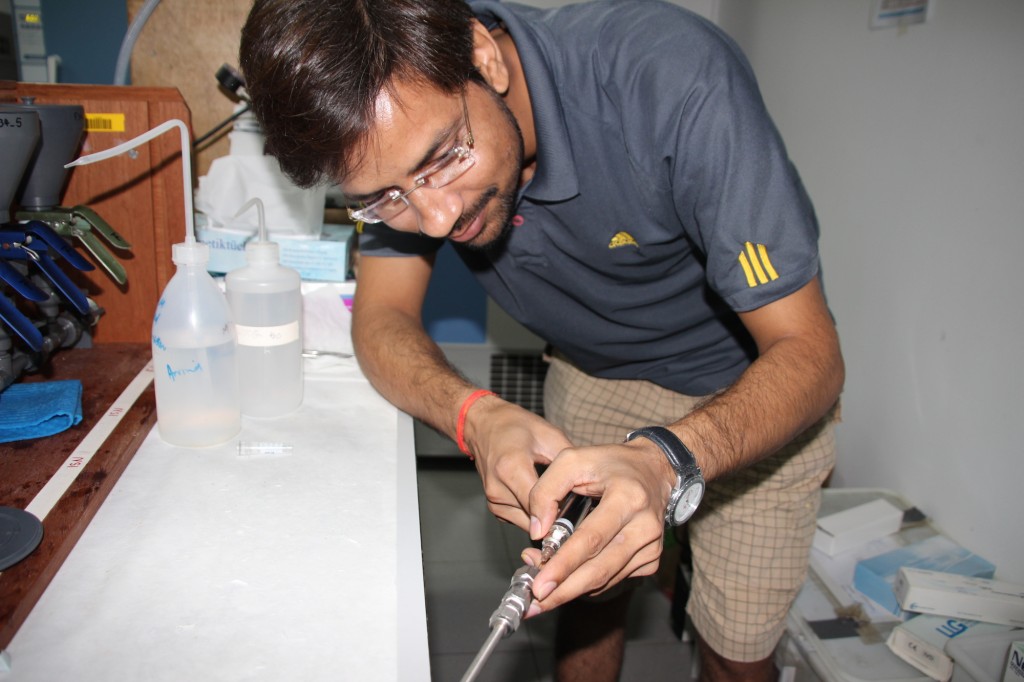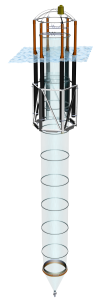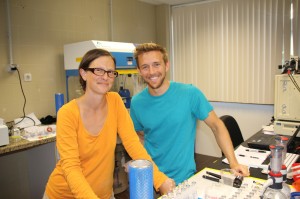[deutsche Version unten]
The experiment is already running for four weeks now and we still haven’t introduced all members of the project. Starting with the
series “Who is KOSMOS” we take the chance to present each of the groups taking part in the study. As an alphabetic order seems rather boring, we will follow an order our mesocosms dictate. Starting at the surface, where the atmosphere meets the ocean, we’ll go down the water column until we eventually reach the sediment trap.
So without further ado, we start off with the people interested in air-sea fluxes or processes related to the surface ocean.
Team DMSP (Dimethylsulfoniopropionate) consists of Steve Archer, Kerstin Suffrian and Kevin Posman . The non-scientific readers of the blog are probably not familiar with this chemical compound you can find in many marine plants. However, you all have probably smelled it’s breakdown product DMS, as it’s what you know as the “smell of the sea” when you walk along the coast. Although this alone doesn’t quite justify the interest of us in DMSP, the fact that DMS is believed to have an influence on cloud formation and ultimately the earth’s heat budget does.
With a travel time of more than 10 hours, they are certainly the ones furthest away from their home institute, the Bigelow Laboratory for Ocean Sciences.
Next up we have Team Nitrogen fixation. Arvind Singh and Stephanie Linsenbarth are looking at both heterotrophic and autotrophic nitrogen fixation in the mesocosms. It is believed, that nitrogen fixers have an advantage in oligotrophic (nutrient poor) waters. Where other organisms starve, they simply take the missing nitrate from the atmosphere. Smart, ey? Will they outcompete others in this study? And how will they deal with future ocean conditions? Arvind and Stephanie will hopefully find some missing pieces to this puzzle during the KOSMOS experiment.
This is it for the first part of the series “Who is KOSMOS”! Stay tuned to meet the rest of the “gang”, they are a lovely bunch!
Paul
_______
Das Experiment läuft nun schon seit fast vier Wochen und wir haben immernoch nicht alle Teilnehmer vorgestellt. Daher fangen wir die Reihe von Beiträgen “Wer ist KOSMOS” an, in der wir die Chance nutzen jede Gruppe einzeln vorzustellen. Da ein alphabetisches Vorgehen etwas langweilig ist, folgen wir dem Mesokosmos einfach in die Tiefe. Wir beginnen an der Grenze von Atmosphäre zum Ozean und arbeiten uns durch die Wassersäule bis zur Sedimentfalle durch.
Kommen wir also, ohne weiter Umstände, zu den Gruppen, welche sich mit Luft-Wasser Flüssen und Prozessen im Oberflächenozean beschäftigen.
Team DMSP (Dimethylsulfoniopropionate) besteht aus Steve Archer, Kerstin Suffrian und Kevin Posman. Dem nicht-wissenschaftlichen Leser dieses Blogs mag diese chemische Verbindung, die man in vielen marinen Pflanzen findet, nicht viel sagen. Und doch gehe ich jede Wette ein, dass jedem dessen Abbauprodukt DMS bekannt ist. Dieses ist nämlich leicht flüchtig und für den allgemein hin bekannten „Seegeruch“ des Meeres verantwortlich. Ein Interessanter Fakt, aber bei einem romantischen Strandspaziergang, mag der Satz „Hier riecht es aber sehr nach DMS“ zwar fachlich korrekter, aber nicht wirklich passend klingen. Dies ist natürlich nicht der Grund, warum Team DMSP an diesem Stoff interessiert ist. Vielmehr hat es mit der Rolle von DMS in der Wolkenbildung zu tun. Es ist damit ein möglicherweise wichtiger Faktor in der Regulierung des Wärmehaushalts unserer Erde.
Mit einer Anreisezeit von mehr als 10 Stunden, ist das Team vom Bigelow Laboratory for Ocean Sciences aus den USA auf jeden Fall jenes, mit der größten Entfernung von zu Hause.
Als nächstes haben wir das Team Nitrogen fixation. Arvind Singh und Stephanie Linsenbarth sind an heterotropher und autotropher Fixierung von Stickstoff in den Mesokosmen interessiert. Man vermutet, dass jene Organismen, die Stickstoff fixieren können in nährstoffarmen Gewässern im Vorteil sind. Wo andere Hunger leiden, ziehen diese einfach den fehlenden Stickstoff aus der Atmosphäre. Schlau, oder? Werden diese Organismen anderen überlegen sein? Und wie werden sie mit den Bedingungen im zukünftigen Ozean klarkommen?
Arvind und Stephanie werden sicherlich einige der fehlenden Puzzle-Teile während des KOSMOS Experiments finden.
Damit beende ich den ersten Teil der Serie “Wer ist KOSMOS”! Folgt unseren Beiträgen um auch noch den Rest der “Gang” kennen zu lernen! Es lohnt sich, ist ‘ne lustige Truppe!
Paul


